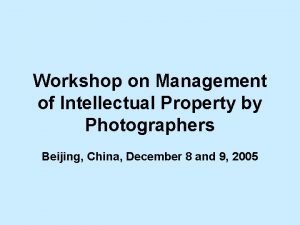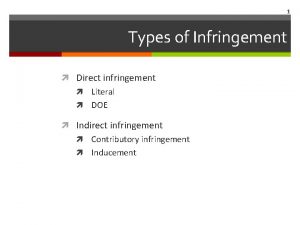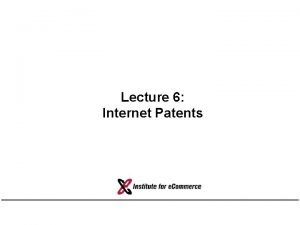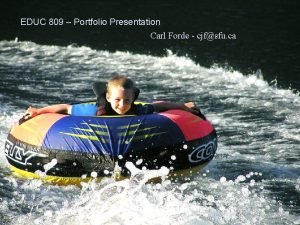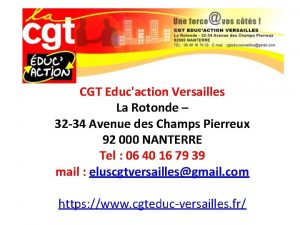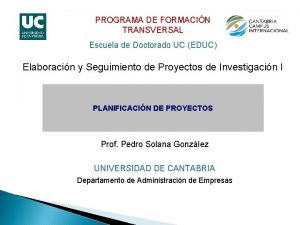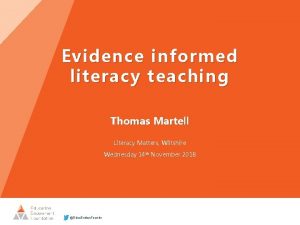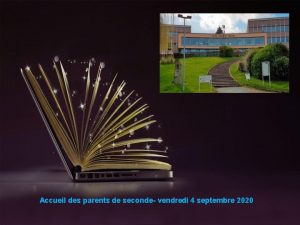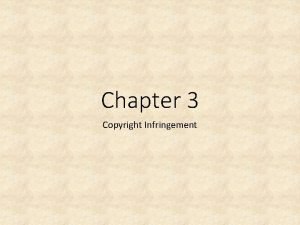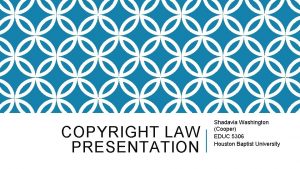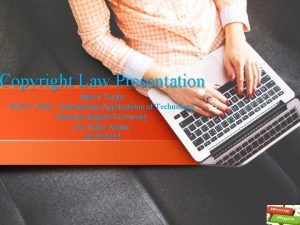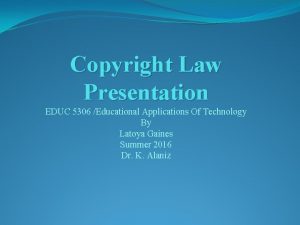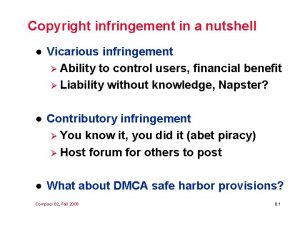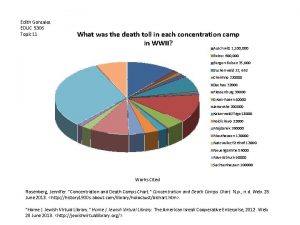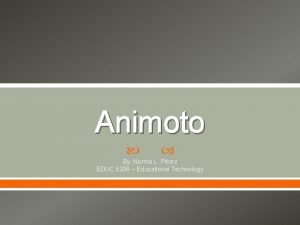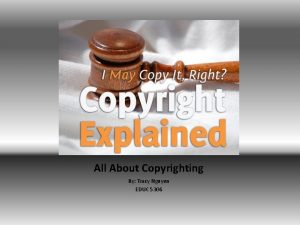COPYRIGHT EDUC 5306 Adrin Garca Mendoza COPYRIGHT INFRINGEMENT









- Slides: 9

COPYRIGHT EDUC 5306 Adrián García Mendoza

COPYRIGHT INFRINGEMENT CONTENTS DEFINITION. Copyright infringement is the use of worksprotected by copyright law without permission, infringing certain exclusive DEFINITION. Copyright infringement is the use of rights granted to the copyright holder, such as the right to reproduce, distribute, display or perform the protected work, or to make derivative works. The copyright holder is typically the work's creator, or a publisher or other business to whom copyright has been assigned. Copyright holders routinely invoke legal and technological measures to prevent and penalize copyright infringement. (a) Anyone who violates any of the exclusive rights of the copyright owner as provided by sections 106 through 122 or of the author (a) Anyone who violates any of the exclusive rights of the copyright owner as provided by sections 106 through as provided in section 602, is an as provided in section 106 A(a), or who imports copies or phonorecords into the United States in violation of section 602, infringer of the copyright or right of the author, as the case may be. For purposes of this chapter (other than section 506), any infringer of the copyright or right of the author, as the case may be. For purposes of this chapter (other than reference to copyright shall be deemed to include the rights conferred by section 106 A(a). As used in this subsection, the term “anyone” includes any State, any instrumentality of a State, and any officer or employee of a State or instrumentality of a State acting in his or her official capacity. Any State, and any such instrumentality, officer, or employee, shall be subject to the provisions of this title in the same manner and to the same extent as any nongovernmental entity. (b) The legal or beneficial owner of an exclusive right under a copyright is entitled, subject to the requirements of section 411, to (b) The legal or beneficial owner of an exclusive right under a copyright is entitled, subject to the requirements of section 411, to institute an action for any infringement of that particular right committed while he or she is the owner of it. The court may require such owner to serve written notice of the action with a copy of the complaint upon any person shown, by the records of the Copyright Office or otherwise, to have or claim an interest in the copyright, and shall require that such notice be served upon any person whose interest is likely to be affected by a decision in the case. The court may require the joinder, and shall permit the intervention, of any person having or claiming an interest in the copyright. (c) For any secondary transmission by a cable system that embodies a performance or a display of a work which is actionable as an act of infringement under subsection (c) of section 111, a television broadcast station holding a copyright or other license to transmit act of infringement under subsection (c) of section 111, a television broadcast station holding a copyright or other license to transmit or perform the same version of that work shall, for purposes of subsection (b) of this section, be treated as a legal or beneficial owner if such secondary transmission occurs within the local service area of that television station.

COPYRIGHT INFRINGEMENT CONTENTS (d) For any secondary transmission by a cable system that is actionable as an act of infringement pursuant to section 111(c)(3), the following shall also have standing to sue: (i) the primary transmitter whose transmission has been altered by the cable system; and (ii) any broadcast station within whose local service area the secondary transmission occurs. (e) With respect to any secondary transmission that is made by a satellite carrier of a performance or display of a work embodied in a primary transmission and is actionable as an act of infringement under section 119(a)(5), a network station holding a copyright or other license to transmit or perform the same version of that work shall, for purposes of subsection (b) of this section, be treated as a legal or beneficial owner if such secondary transmission occurs within the local service area of that station. (f)(1) With respect to any secondary transmission that is made by a satellite carrier of a performance or display of a work embodied in a primary transmission and is actionable as an act of infringement under section 122, a television broadcast station holding a copyright or other license to transmit or perform the same version of that work shall, for purposes of subsection (b) of this section, be treated as a legal or beneficial owner if such secondary transmission occurs within the local market of that station. (2) A television broadcast station may file a civil action against any satellite carrier that has refused to carry television broadcast signals, as required under section 122(a)(2), to enforce that television broadcast station’s rights under section 338(a) of the Communications Act of 1934.

FAIR USE (DEFINITION) In its most general sense, a fair use is any copying of copyrighted material done for a limited and “transformative” purpose, such as to comment upon, criticize, or parody a copyrighted work. Such uses can be done without permission from the copyright owner. In other words, fair use is a defense against a claim of copyright infringement. If your use qualifies as a fair use, then it would not be considered an illegal infringement. So what is a “transformative” use? If this definition seems ambiguous or vague, be aware that millions of dollars in legal fees have been spent attempting to define what qualifies as a fair use. There are no hard-and-fast rules, only general rules and varied court decisions, because the judges and lawmakers who created the fair use exception did not want to limit its definition. Like free speech, they wanted it to have an expansive meaning that could be open to interpretation.

FAIR USE Most fair use analysis falls into two categories: (1) commentary and criticism, or (2) parody. Commentary and Criticism If you are commenting upon or critiquing a copyrighted work — for instance, writing a book review — fair use principles allow you to reproduce some of the work to achieve your purposes. Some examples of commentary and criticism include: quoting a few lines from a Bob Dylan song in a music review summarizing and quoting from a medical article on prostate cancer in a news report copying a few paragraphs from a news article for use by a teacher or student in a lesson, or copying a portion of a Sports Illustrated magazine article for use in a related court case. The underlying rationale of this rule is that the public reaps benefits from your review, which is enhanced by including some of the copyrighted material. Additional examples of commentary or criticism are provided in the examples of fair use cases. Parody A parody is a work that ridicules another, usually well-known work, by imitating it in a comic way. Judges understand that, by its nature, parody demands some taking from the original work being parodied. Unlike other forms of fair use, a fairly extensive use of the original work is permitted in a parody in order to “conjure up” the original.

COPYRIGHT INFRINGEMENT FOR STUDENTS Text · Up to 10% of a copyrighted work or 1000 words, whichever is less · Poems - Entire poem if less than 250 words - 250 words or less if longer poem - No more than 5 poems (or excerpts) of different poets, from an anthology - Only 3 poems (or excerpts) per poet Motion Media - Up to 10% of a copyrighted work or 3 minutes, whichever is less - Clip cannot be altered in any way Illustrations - A photograph or illustration may be used in its entirety - No more than 5 images of an artist's or photographer's work - When using a collection, no more than 10% or no more than 15 images, whichever is less Music - Up to 10% of a copyrighted musical composition, but no more than 30 seconds - Up to 10% of a body of sound recording, but no more than 30 seconds - Any alterations cannot change the basic melody or the fundamental character of the work

COPYRIGHT INFRINGEMENT FOR STUDENTS Internet - Internet resources often combine both copyrighted and public domain sites; therefore care should be used in downloading any sites for use in multimedia presentations. - Until further clarification, educators and students are advised to write for permission to use Internet resources and to be mindful of the copyright ramifications of including embedded additional links to that particular site. Numerical Data Sets - Up to 10% or 2500 fields or cell entries, whichever is less, from a copyrighted database or data table - A field entry is defined as a specific item of information (e. g. name, Social Security number) in a record of a database file. - A cell entry is defined as the intersection where a row and a column meet on a spreadsheet Copying and Distribution Limitations - Do not post multimedia projects claiming fair use exemption on an unsecured web site - No more than 2 copies of the original production may be made - Only 1 may be placed on reserve for others to use for instructional purposes - An additional copy may be made for preservation purposes, but may be used or copied only to replace a use copy that has been lost, damaged, or stolen - If more than one person has created the multimedia presentation, each principal creator may retain only one copy Alteration Limitations - Multimedia selections falling within the above guidelines may be altered to illustrate a specific technique or to support a specific instructional objective - Notation of the alteration should be documented within the presentation itself

COPYRIGHT INFRINGEMENT FOR STUDENTS Multimedia Presentations Citations available. - Educators and students must credit sources, giving full bibliographic information when - Educators and students must display the copyright notice and copyright ownership information if this is shown in the original source. - Copyright information for images may be shown in a separate bibliographic section unless the presentation is being used for distance learning. In this case, the information must be incorporated within the image itself (i. e. it must appear on the screen when the image is viewed). Permission Requirements - For multimedia projects used for non-educational or commercial purposes - For duplication or distribution of multimedia projects beyond limitations outlined above

RESOURCES http: //www. copyright. gov/ http: //fairuse. stanford. edu/ http: //www. ncpublicschools. org/copyright 1. html http: //www. copyright. com/ https: //www. wikipedia. org/
